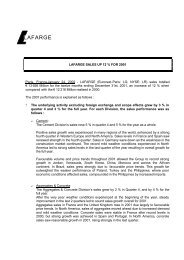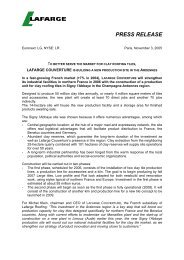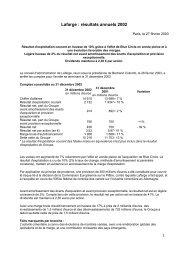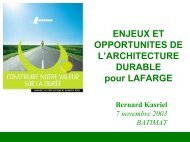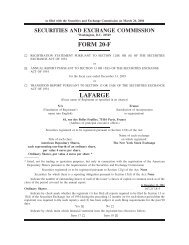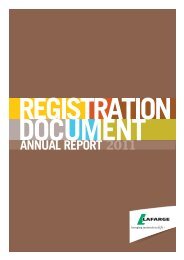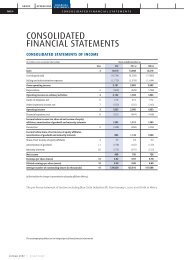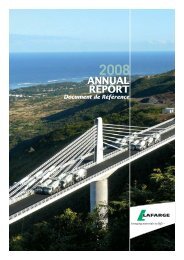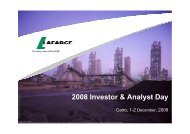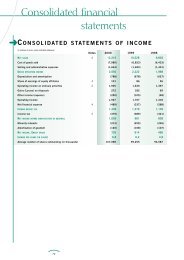2005 Sustainability Report - Lafarge
2005 Sustainability Report - Lafarge
2005 Sustainability Report - Lafarge
Create successful ePaper yourself
Turn your PDF publications into a flip-book with our unique Google optimized e-Paper software.
Our<br />
approach<br />
INTERVIEW WITH<br />
OLIVIER LUNEAU,<br />
SENIOR VICE PRESIDENT<br />
SUSTAINABLE DEVELOPMENT<br />
AND PUBLIC AFFAIRS<br />
PAGE 04 | <strong>2005</strong> SUSTAINABILITY REPORT | LAFARGE<br />
The sustainability<br />
approach of a Group<br />
like <strong>Lafarge</strong><br />
is continuously<br />
being enhanced<br />
How do you account for the vitality of the Group’s<br />
sustainable development approach?<br />
This vitality is fueled by the 2,000 sites that we operate in 76 countries. Each plant<br />
has to deal with different economic, social and environmental conditions, and it is<br />
up to our employees to develop the necessary solutions: the expectations of local<br />
communities around a plasterboard facility in the United States differ from those at<br />
one of our quarries in France. Our markets and customers are generally located very<br />
close to our facilities from a geographical standpoint: 60 minutes from a concrete plant<br />
to a customer. It is therefore critical for us to build a strong local presence and our<br />
global performance depends on our capacity to become a seamless part of the local<br />
fabric. This vitality can be measured through the very numerous initiatives implemented<br />
locally. The ones implemented with Care International and Habitat for Humanity<br />
have subsequently been pursued Group-wide. <strong>Lafarge</strong> cannot move forward on its own:<br />
stakeholders and our panel challenge us regularly and act as critical friends if we appear<br />
to lose our momentum... This is how we are constantly improving our approach.<br />
What are the aims for the future?<br />
Nothing can ever be taken for granted: society's needs are constantly evolving, and<br />
communities' expectations are changing. We need to be able to listen, to state our<br />
ambitions and to be credible in our results. Our methods probably represent the area<br />
in which we can make the most progress by focusing on:<br />
• More effectively embedding sustainable development in the Group's strategy: our<br />
businesses have a significant environmental footprint. We need to reduce it (reduction<br />
of CO2 emissions, quarry rehabilitation) and to develop products and construction<br />
systems consistent with the needs of a more sustainable construction: products that<br />
are easier to use, construction systems improving buildings' energy efficiency and<br />
greater safety for our employees and our subcontractors.<br />
• Concerning our approach: increasing the emphasis on sustainable development and<br />
relations with stakeholders, by incorporating them into managers' training cycles<br />
and ensuring consistency with the Group's internal goals.<br />
• Greater emphasis on listening and transparency: this approach needs to be developed<br />
and become institutionalized so that it can always guarantee that the Group does not<br />
become isolated from its stakeholders.<br />
• The link between objectives (crystal-clear and specific) and results is critical. We have<br />
begun to have our results reviewed and certified by an external organization. For<br />
instance, since 2001, the audited results of our CO2 emissions have been reported<br />
to WWF International, who thus monitors our progress.<br />
As you can see, we still have a lot of work to do! This is what makes my job exciting<br />
because the challenges facing the Group are real, as is the Group's determination to<br />
meet them.




